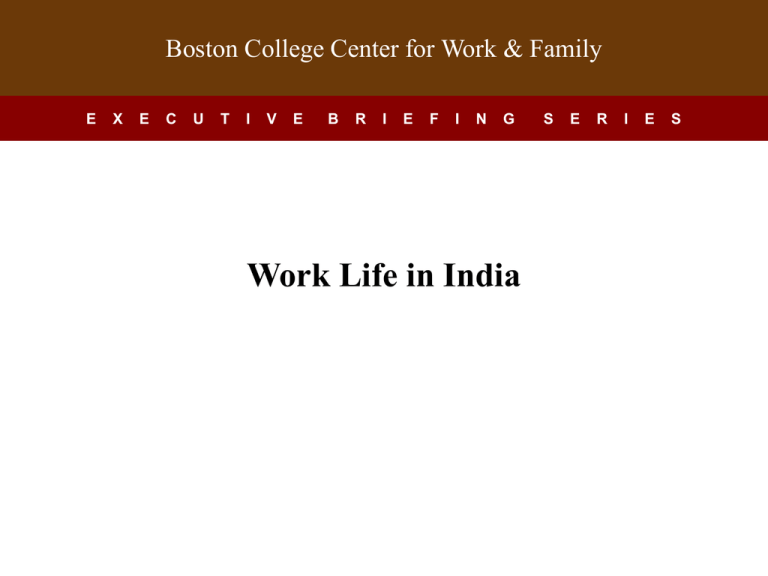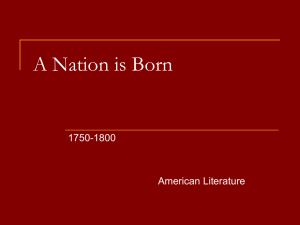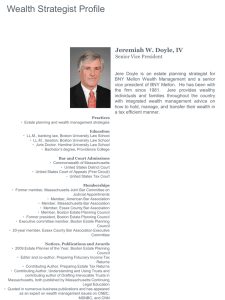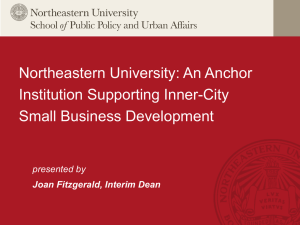EBS Presentation Slides
advertisement

Boston College Center for Work & Family E X E C U T I V E B R I E F I N G Work Life in India S Work-Life in China E R I E S This presentation is a companion to the Boston College Center for Work & Family Executive Briefing Series. It is designed to be customized by your organization. Please feel free to cut and paste these slides into your own format, and to use the information provided as a guide to develop your own presentation. If you do not have a copy of the full Briefing, please email: cwf@bc.edu or visit our website for the briefing and bibliography http://www.bc.edu/centers/cwf/research/publications.html#executivebrifingseries . Boston College Center for Work & Family, ©2009 Agenda • Indian context •Work and family study in India •Nature of non-institutional support for work-life balance in India •Government policies •Organizational case studies •What can organizations do further? Boston College Center for Work & Family, ©2009 Indian society – Complexities and Contradictions • Old civilization, relatively new nation-state • Diversity of traditions, languages, religions, economic realities • Majority Hindus (80%), Muslims (14%) • Caste system and its modern avatar • Traditional Indian family – patriarchal and joint • Status of women - low but changing • Educational trends in modern India – emphasis on higher education, science and technology • Economic changes in modern India – rising urban middle class, rising growth rates, rising income inequalities Boston College Center for Work & Family, ©2009 Work and family study in India • Research on work and family in India has followed two separate paths – – Women’s studies Psychosocial research • Mid 70s – mid 80s: Exploratory studies mainly on working women, preoccupied with changing status and roles of working women and societal perceptions of them. • Mid 80s – mid 90s: Inclusion of men in samples, results showed greater responsibility for family duties rested with women, women were more stressed. • Mid 90s –mid 2000: More studies on dual career as opposed to dual worker couples, no significant differences in conflict and stress for men and women, however sources of stress and conflict differed. • 2000 onwards: Some focus on organizational policies towards women, increasing concern about how the ITES sector is affecting work-life balance for `all’ employees. Boston College Center for Work & Family, ©2009 How is the work-life agenda set in India? • Depends critically on the role and status of the woman – working or non-working - and the income level of the family. • Discussion of work-life balance issues by companies in India is really a study of women, work and family in the urban, middle class context. • Motivation for companies to offer family-friendly measures - maintain uniformity in HR practices globally, demand by younger men and women employees , retention tool . Boston College Center for Work & Family, ©2009 Support for work-life balance in India • Largely non-institutional and nonorganizational • Comes mainly from the family • Bound in relationships of dependence and counter-dependence • Informal, ad hoc and contingent in nature Boston College Center for Work & Family, ©2009 Nature of non-institutional support for work-life balance in India • Extended family – mainly in-laws / parents - depends on their availability, health, relationship with daughter-in-law(s) of the house and number of siblings sharing this support • Paid help / maid – depends on reliability of maid, money that you can afford to pay, specific circumstances in maid’s personal and extended family • Spouse – depends on attitude of spouse (husband), nature of job, presence of other sources of support such as parents / in-laws and maid. • Self – depends on your own attitude, resourcefulness and willingness to deviate from the norms. • Friends and neighbors – depends on how much you share in common with them and on whether they are located physically close to you. Boston College Center for Work & Family, ©2009 Government Policies • http://nrcw.nic.in/ - website of the National Resource Center for Women • Maternity Benefits Act (1961) 12 weeks paid leave for child birth. • Factories Act (1948) - employer must provide a crèche where more than 30 women workers are employed with children below 6 years. • Amendment to the Indian Penal Code (1869) Section 509 as per Vishakha case (Supreme Court) – To prevent and address sexual harassment of women in the workplace. Boston College Center for Work & Family, ©2009 Government Policies (contd.) Pitfalls: • No national laws specifically covering rights to shared family responsibilities/ part-time workers/ home workers/knowledge-workers • Factories Act (1948) - prohibits women from being employed on the shop floor in heavy machinery- leading to low female employment in thrust areas of growth. • By-passing of legislation by organizations to circumvent laws and lack of pressure for formal policies at the organizational level to support work and family. Boston College Center for Work & Family, ©2009 Organizational case studies - INFOSYS • Infosys – HALE – Health Assessment Lifestyle Initiative – A portal for online dissemination of information on stress related issues and a hotline whereby the employees can directly receive counseling and expert opinions. - Data from portal & hotline used by HR to track key indicators like absenteeism rate with causes and resultant billing losses. Boston College Center for Work & Family, ©2009 Organizational case studies - WIPRO • WIPRO – Nutrition consulting, Health centers, medical camps and regular Well-being events like the Annual Wipro marathon. • Project MITR which means ‘friend’ in Hindi - 28 employees, all volunteers, are trained to counsel fellow employees to manage stress. • “Mitr” signifies to employees that they do have a friend in Wipro and that they should be able to confide and share their problems with us. Boston College Center for Work & Family, ©2009 Organizational case studies – TATA MOTORS • Tata Motors – community development initiatives and women’s cooperatives called `grihini udyogs’ run by wives of company employees. • Provide the company with a variety of products ranging from cables for vehicles to chapattis (Indian bread) for its cafeteria. Some products are sold in the open market. • Provide extra income to employees and their families. The women are paid the government-prescribed minimum wage and they also get all statutory benefits. Boston College Center for Work & Family, ©2009 Organizational case studies – CISCO, India • WAN – Women’s Action Network set up in in 2004 – has more than 350 employees as its members. • WAN activities are managed by a core team of volunteers lead by the WAN leads, under the guidance of executive sponsors and thought leaders. • Some of Cisco WAN India’s activities include mentoring, professional workshops like the Role Model Leadership Series (RMLS) workshops, community initiatives - Girls in Technology, Adopting charities focused on education, networking events and `Bring your kids to work' day. Boston College Center for Work & Family, ©2009 Organizational case studies – Johnson & Johnson, India • Women’s Leadership Initiative (WLI) in 2002 with the backing of top management. • Aimed at removing barriers to the advancement of women within the company and at attracting and developing women leaders in the company. • Comprises of 5 task forces created to work on areas of policies, learning and developing and networking. • J&J, India also undertakes several community initiatives focused on improving awareness of health issues surrounding diabetes and AIDS, providing support to street children orphans and tribal girls, and providing maternity and gynecological care to women in need. Boston College Center for Work & Family, ©2009 Organizational case studies – IBM, India • IBM, India undertakes measures for the advancement of women and for promoting workplace flexibility as part of its global diversity initiatives • Based on the three pillars of equal opportunity, affirmative action and work/life balancing programs. • Measures are focused on mentoring and coaching for women, attending internal and external conferences and symposia, participating in steering committees, emphasizing on executive and technical resources programs, regularly carrying out work/personal life employee surveys and develop diversity-specific hiring programs. Boston College Center for Work & Family, ©2009 What can organizations do further? • Productivity – Invest in training of employees – Encourage effective use of technology at work and home – Reduce hassles of daily living e.g. commuting stress Boston College Center for Work & Family, ©2009 What can organizations do further? • Stress reduction – Relatively less emphasis on providing gyms and exercise facilities at work and more emphasis on creating a supportive work culture – More avenues for creative expression and social interaction with friends – More health awareness, especially about good nutrition and sleep habits Boston College Center for Work & Family, ©2009 What can organizations do further? • Managing health of aging parents – Provide a kind of FMLA leave to allow employees to manage health issue of aging parents for who are their responsibility, in addition to health coverage for parents/dependents. – Contract with reputed hospitals and nursing homes to develop a vendor list of reputed nursing care providers. Boston College Center for Work & Family, ©2009 What can organizations do further? • Managing the juggling act – More child care facilities closer to employees homes and not just at the workplace – Supply of better quality paid help for household chores .e.g bonded and insured house cleaning services. – Concierge services that will also work on weekends Boston College Center for Work & Family, ©2009 Contact us! Boston College Center for Work & Family 22 Stone Avenue Chestnut Hill, MA 02467 Phone: (617) 552-2844 Fax: (617) 552-2859 E-mail: cwf@bc.edu Web site: www.bc.edu/cwf Boston College Center for Work & Family, ©2009










